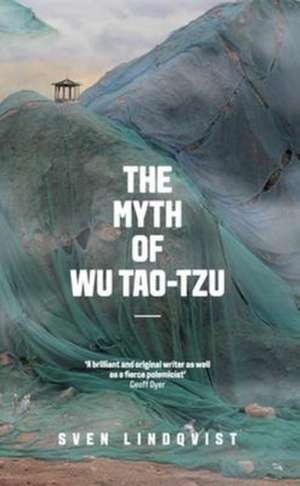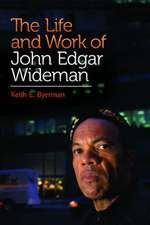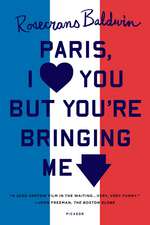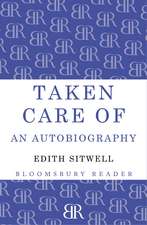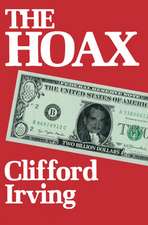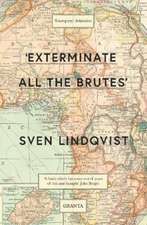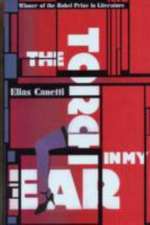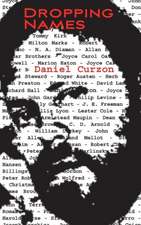The Myth of Wu Tao-Tzu: A Biography of the Ordnance Survey
Autor Sven Lindqvisten Limba Engleză Paperback – aug 2012
'During the Tang dynasty, the Chinese artist Wu Tao-tzu was one day standing looking at a mural he had just completed. Suddenly, he clapped his hands and the temple gate opened. He went into his work and the gates closed behind him.' Thus begins Sven Lindqvist's profound meditation on art and its relationship with life, first published in 1967, and a classic in his home country - it has never been out of print.
As a young man, Sven Lindqvist was fascinated by the myth of Wu Tao-tzu, and by the possibility of entering a work of art and making it a way of life. He was drawn to artists and writers who shared this vision, especially Hermann Hesse, in his novel Glass Bead Game. Partly inspired by Hesse's work, Lindqvist lived in China for two years, learning classical calligraphy from a master teacher. There he was drawn deeper into the idea of a life of artistic perfectionism and retreat from the world. But when he left China for India and then Afghanistan, and saw the grotesque effects of poverty and extreme inequality, Lindqvist suffered a crisis of confidence and started to question his ideas about complete immersion in art at the expense of a proper engagement with life. The Myth of Wu Tao-tzu takes us on a fascinating journey through a young man's moral awakening and his grappling with profound questions of aesthetics. It contains the bracing moral anger, and poetic, intensely atmospheric travel writing Lindqvist's readers have come to love.
As a young man, Sven Lindqvist was fascinated by the myth of Wu Tao-tzu, and by the possibility of entering a work of art and making it a way of life. He was drawn to artists and writers who shared this vision, especially Hermann Hesse, in his novel Glass Bead Game. Partly inspired by Hesse's work, Lindqvist lived in China for two years, learning classical calligraphy from a master teacher. There he was drawn deeper into the idea of a life of artistic perfectionism and retreat from the world. But when he left China for India and then Afghanistan, and saw the grotesque effects of poverty and extreme inequality, Lindqvist suffered a crisis of confidence and started to question his ideas about complete immersion in art at the expense of a proper engagement with life. The Myth of Wu Tao-tzu takes us on a fascinating journey through a young man's moral awakening and his grappling with profound questions of aesthetics. It contains the bracing moral anger, and poetic, intensely atmospheric travel writing Lindqvist's readers have come to love.
Preț: 80.77 lei
Nou
Puncte Express: 121
Preț estimativ în valută:
15.46€ • 16.17$ • 12.84£
15.46€ • 16.17$ • 12.84£
Carte disponibilă
Livrare economică 13-27 martie
Livrare express 26 februarie-04 martie pentru 15.21 lei
Preluare comenzi: 021 569.72.76
Specificații
ISBN-13: 9781847085221
ISBN-10: 1847085229
Pagini: 110
Dimensiuni: 141 x 216 x 9 mm
Greutate: 0.13 kg
Editura: Granta Books
ISBN-10: 1847085229
Pagini: 110
Dimensiuni: 141 x 216 x 9 mm
Greutate: 0.13 kg
Editura: Granta Books
Recenzii
Turn to his depiction of the great Buddhist statues of Longmen and you encounter some of the most graphic, original and sophisticated descriptive writing on China. His visit to a Beijing bathhouse is a small jewel of empathy. Just as you feel he is wandering too convoluted a mystical labyrinth, he introduces a statement of cool critical force... complex, shifting and endlessly self-reflexive - Colin Thubron, The Times
Lindqvist has developed a literary form flexible enough for him to travel in time as much as space, combining the personal and the political, mingling historical investigation, travel and literary reportage and - increasingly - fierce polemic - Stuart Jeffries, Guardian
A writer of rare political engagement, [who], in order to convey the complexity and urgency of his beliefs, created a wholly new form of non-fiction. Philosophy, travel, memoir, essay, aphorism and polemic are all interwoven in his works - Stuart Kelly, Scotsman
This accessible mix of travel-writing and memoir takes Lindqvist from Sweden to China to pay homage to the Chinese artist who legend has it stepped into the very mural he had just painted and disappeared - Lesley McDowell, Sunday Herald
Necessary and transformative... Lindqvist is a master-conjurer, creating a world in which dreams and reality are intermingled and where the line between fantasy and fate is blurred. His prose is spare, flinty, but beautifully balanced and packed with detail... Once you've stepped into Lindqvist's world, things will never look the same again - Gavin Francis, author, Empire Antarctica
A lyrical, but hard-hitting, examination of the ways in which we use art as escapism - Arminta Wallace, Irish Times
It smoulders with fury at man's inhumanity... Flinty, direct and utterly original - Gavin Francis, Books of the Year, Scotland on Sunday
Lindqvist has developed a literary form flexible enough for him to travel in time as much as space, combining the personal and the political, mingling historical investigation, travel and literary reportage and - increasingly - fierce polemic - Stuart Jeffries, Guardian
A writer of rare political engagement, [who], in order to convey the complexity and urgency of his beliefs, created a wholly new form of non-fiction. Philosophy, travel, memoir, essay, aphorism and polemic are all interwoven in his works - Stuart Kelly, Scotsman
This accessible mix of travel-writing and memoir takes Lindqvist from Sweden to China to pay homage to the Chinese artist who legend has it stepped into the very mural he had just painted and disappeared - Lesley McDowell, Sunday Herald
Necessary and transformative... Lindqvist is a master-conjurer, creating a world in which dreams and reality are intermingled and where the line between fantasy and fate is blurred. His prose is spare, flinty, but beautifully balanced and packed with detail... Once you've stepped into Lindqvist's world, things will never look the same again - Gavin Francis, author, Empire Antarctica
A lyrical, but hard-hitting, examination of the ways in which we use art as escapism - Arminta Wallace, Irish Times
It smoulders with fury at man's inhumanity... Flinty, direct and utterly original - Gavin Francis, Books of the Year, Scotland on Sunday
Turn to his depiction of the great Buddhist statues of Longmen and you encounter some of the most graphic, original and sophisticated descriptive writing on China. His visit to a Beijing bathhouse is a small jewel of empathy. Just as you feel he is wandering too convoluted a mystical labyrinth, he introduces a statement of cool critical force... complex, shifting and endlessly self-reflexive - Colin Thubron, The TimesLindqvist has developed a literary form flexible enough for him to travel in time as much as space, combining the personal and the political, mingling historical investigation, travel and literary reportage and - increasingly - fierce polemic - Stuart Jeffries, GuardianA writer of rare political engagement, [who], in order to convey the complexity and urgency of his beliefs, created a wholly new form of non-fiction. Philosophy, travel, memoir, essay, aphorism and polemic are all interwoven in his works - Stuart Kelly, ScotsmanThis accessible mix of travel-writing and memoir takes Lindqvist from Sweden to China to pay homage to the Chinese artist who legend has it stepped into the very mural he had just painted and disappeared - Lesley McDowell, Sunday HeraldNecessary and transformative... Lindqvist is a master-conjurer, creating a world in which dreams and reality are intermingled and where the line between fantasy and fate is blurred. His prose is spare, flinty, but beautifully balanced and packed with detail... Once you've stepped into Lindqvist's world, things will never look the same again - Gavin Francis, author, Empire AntarcticaA lyrical, but hard-hitting, examination of the ways in which we use art as escapism - Arminta Wallace, Irish TimesIt smoulders with fury at man's inhumanity... Flinty, direct and utterly original - Gavin Francis, Books of the Year, Scotland on Sunday
Notă biografică
SVEN LINQVIST was born in Stockholm in 1932. He has published essays, aphorisms, autobiography, documentary prose, travel and reportage, including: Bench Press, Desert Divers, Exterminate All the Brutes, A History of Bombing and Terra Nullius, all available from Granta Books. Lindqvist lives in Stockholm.
Extras
When I first heard the tale of Wu Tao-tzu as a child, entering a picture seemed a very natural thing to do. What else could you do?
Not to enter would have been to miss a golden opportunity. Pictures were few and far between in the 1930s, remember!
In Sweden there was in those days not a single television channel, no lush colour photographs in illustrated magazines, no coffee-table books full of eye-goodies and very few children’s books.
So when I saw a picture that was more than a black smudge on the page, I jumped at it. Or rather, I jumped into it, as if it was a jungle to explore or a room to live in.
The pictures that most excited my fantasy were often those on tins. Tins of sardines, of meat or even of tropical fruit.
Opening the tin was opening the picture.
Smelling the contents brought me to the brink of the picture world.
Eating was entering.
As a schoolboy, a few years later, I had already lost this natural gift of entering into pictures. I now took what seemed to me a more realistic view of the matter. I prepared myself for a career as a practising magician.
An older friend, who was a professional and gave regular paid performances, showed me how some of his tricks were done. I used all my pocket money to buy a cloak, a wand and a top hat full of secret pockets.
Now when I heard the tale of Wu Tao-tzu my question was: how did he do it?
What was the secret behind the opening of the gates at the sound of clapping hands?
How did he manage the art of his own disappearance?
He seemed to have penetrated his painting and found an inner room, a liveable, habitable inner space, behind the surface of art. How was this illusion created?
Or was it, perhaps, not just an illusion? After all, the great German novelist Hermann Hesse spent his whole writing life trying to enact the myth of Wu Tao-tzu. Musil and Proust were not far behind.
The more I studied the myth of Wu Tao-tzu, the more I was fascinated by the possibilities it opened up.
Questions multiplied.
Why did he disappear?
What company did he leave behind?
Did he experience the culture of his day as desperate and meaningless?
Or was his vanishing an act of artistic self-confidence? An attempt to verify art in life?
Wu Tao-tzu had the courage for solitude. That is what is so tempting about his fate. He had the courage to disappear and continue alone, on the other side of the visible in art.
Not to enter would have been to miss a golden opportunity. Pictures were few and far between in the 1930s, remember!
In Sweden there was in those days not a single television channel, no lush colour photographs in illustrated magazines, no coffee-table books full of eye-goodies and very few children’s books.
So when I saw a picture that was more than a black smudge on the page, I jumped at it. Or rather, I jumped into it, as if it was a jungle to explore or a room to live in.
The pictures that most excited my fantasy were often those on tins. Tins of sardines, of meat or even of tropical fruit.
Opening the tin was opening the picture.
Smelling the contents brought me to the brink of the picture world.
Eating was entering.
As a schoolboy, a few years later, I had already lost this natural gift of entering into pictures. I now took what seemed to me a more realistic view of the matter. I prepared myself for a career as a practising magician.
An older friend, who was a professional and gave regular paid performances, showed me how some of his tricks were done. I used all my pocket money to buy a cloak, a wand and a top hat full of secret pockets.
Now when I heard the tale of Wu Tao-tzu my question was: how did he do it?
What was the secret behind the opening of the gates at the sound of clapping hands?
How did he manage the art of his own disappearance?
He seemed to have penetrated his painting and found an inner room, a liveable, habitable inner space, behind the surface of art. How was this illusion created?
Or was it, perhaps, not just an illusion? After all, the great German novelist Hermann Hesse spent his whole writing life trying to enact the myth of Wu Tao-tzu. Musil and Proust were not far behind.
The more I studied the myth of Wu Tao-tzu, the more I was fascinated by the possibilities it opened up.
Questions multiplied.
Why did he disappear?
What company did he leave behind?
Did he experience the culture of his day as desperate and meaningless?
Or was his vanishing an act of artistic self-confidence? An attempt to verify art in life?
Wu Tao-tzu had the courage for solitude. That is what is so tempting about his fate. He had the courage to disappear and continue alone, on the other side of the visible in art.
Descriere
'During the Tang dynasty, the Chinese artist Wu Tao-tzu was one day standing looking at a mural he had just completed. Suddenly, he clapped his hands and the temple gate opened. He went into his work and the gates closed behind him.' Thus begins Sven Lindqvist's profound meditation on art and its relationship with life, first published in 1967, and a classic in his home country - it has never been out of print.
As a young man, Sven Lindqvist was fascinated by the myth of Wu Tao-tzu, and by the possibility of entering a work of art and making it a way of life. He was drawn to artists and writers who shared this vision, especially Hermann Hesse, in his novel Glass Bead Game. Partly inspired by Hesse's work, Lindqvist lived in China for two years, learning classical calligraphy from a master teacher. There he was drawn deeper into the idea of a life of artistic perfectionism and retreat from the world. But when he left China for India and then Afghanistan, and saw the grotesque effects of poverty and extreme inequality, Lindqvist suffered a crisis of confidence and started to question his ideas about complete immersion in art at the expense of a proper engagement with life. The Myth of Wu Tao-tzu takes us on a fascinating journey through a young man's moral awakening and his grappling with profound questions of aesthetics. It contains the bracing moral anger, and poetic, intensely atmospheric travel writing Lindqvist's readers have come to love.
As a young man, Sven Lindqvist was fascinated by the myth of Wu Tao-tzu, and by the possibility of entering a work of art and making it a way of life. He was drawn to artists and writers who shared this vision, especially Hermann Hesse, in his novel Glass Bead Game. Partly inspired by Hesse's work, Lindqvist lived in China for two years, learning classical calligraphy from a master teacher. There he was drawn deeper into the idea of a life of artistic perfectionism and retreat from the world. But when he left China for India and then Afghanistan, and saw the grotesque effects of poverty and extreme inequality, Lindqvist suffered a crisis of confidence and started to question his ideas about complete immersion in art at the expense of a proper engagement with life. The Myth of Wu Tao-tzu takes us on a fascinating journey through a young man's moral awakening and his grappling with profound questions of aesthetics. It contains the bracing moral anger, and poetic, intensely atmospheric travel writing Lindqvist's readers have come to love.
